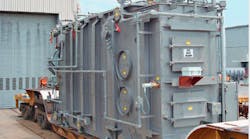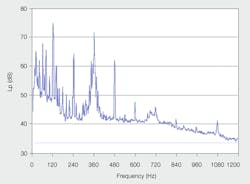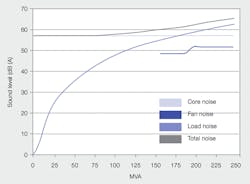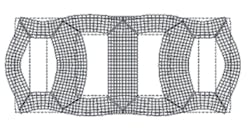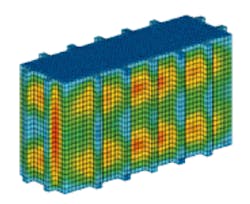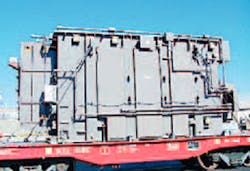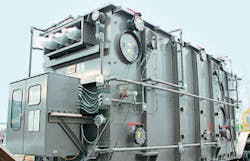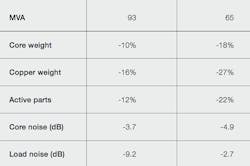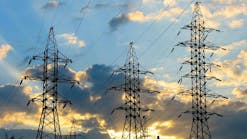Transformer hum is characterized by several pure tones. The frequency of a number of these is in the range where the human ear is most sensitive. Moreover, transformer noise, being of tonal character, causes irritation and discomfort. There are three sources of sound/noise in power transformers:
Core noise
Core noise is caused by the magnetostriction property of core steel. It has components at multiples of 100 or 120 Hz (for 50 Hz and 60 Hz transformers, respectively). The relative magnitudes of the noise at the various harmonics is dependent on core material, core geometry, operating flux density and how close the resonance frequencies of the core and tank are to the exciting frequencies ➔ 1.
1 Typical frequency spectrum of noise produced by a 60 Hz power transformer (Lp = sound pressure level)
Cooling equipment noise
Fan and pump noise is mostly broadband with insignificant low frequency tones.
Load noise
Load noise is mainly generated by the electromagnetic forces that result from the interaction of the load current in the windings and the leakage flux produced by this current. Another source of load noise is tank vibrations caused by the leakage flux impinging on tank walls. The main frequency is twice the supply frequency, ie, 100 Hz for 50 Hz transformers and 120 Hz for 60 Hz transformers. Transformer load noise increases with the load. Also, at higher loads, fans ramp up and add further noise ➔ 2.
2 Noise components and total noise of a 250 MVA transformer
Design features of ABB low-noise transformers
Power transformers of ABB’s present design generation typically have noise levels that are significantly lower than those built 20 or 30 years ago. Some of the more important means to achieving these low levels of transformer noise are:
- Transformer cores are now designed to provide a more uniform distribution of magnetic flux with a lower content of flux harmonics in the core and core joints. Detailed 3-D magnetic field modeling allows optimization of the core and, thus, minimized core noise.
- The core is held together by a clamping structure that provides uniform pressure on the core laminations while avoiding local deformations. ABB’s in–house tools calculate the vibrations of the core, taking different modes of vibrations and mechanical resonance, as well as the complex forces exciting a three–phase transformer core, into account.
- By carefully considering the dynamic properties of the transformer core and tank, it is possible to successfully de-couple core vibrations from the tank. Also, a number of techniques that attempt to reduce the transmissibility of the core vibrations, and hence the resulting sound radiation, are exploited.
- Both core and tank resonances are avoided. This entails accurate pre-determination of resonance frequencies. Acoustic simulations, verified by scale models and full-size experiments, provide the tools needed to avoid core and tank resonances and reduce sound radiation. Sound panels or enclosures covering the entire tank, or parts thereof, have been used for transformers that must fulfill very low levels of noise.
- Winding resonance is avoided and winding designs that provide for lower magnitudes of leakage flux are used.
- Tank vibrations are significantly reduced by shielding against leakage flux.
- Low–noise fans, or sound–absorbing elements at the inlet and outlet, reduce fan noise. In the case of ultralow-noise transformers, fans may not be used at all.
ConEd transformer requirements
Consolidated Edison (ConEd) is a power utility serving New York City. In order to satisfy the stringent limits that the city ordinance imposes on all sources of noise in the city, the ConEd specification for new power transformers has stringent noise requirements:
- A 15 to 20 dB lower total noise level than is typical for corresponding sizes of transformers.
- Guaranteed noise levels not to be exceeded at 100 percent voltage combined with 100 percent load or at maximum over-excitation combined with 40 percent load.
Limits are enforced not only on the total noise levels but also on each individual frequency component of the transformer noise. Taken together, the maximum allowable noise levels of the frequency components correspond to a total noise level of about 54 dB(A) at 100 percent voltage and full current. In comparison, transformers of this size would typically have noise levels in the 70 dB(A) range for no-load (core plus fans) noise alone. This demonstrates the extent of the ConEd noise requirements relative to typical, or even low–noise, transformers. Guaranteeing the level of each frequency component is an order of magnitude more difficult than guaranteeing the total noise level of a transformer.
These were not the only challenges. The ConEd requirements impose other design restrictions, such as tight limits on weight, width and height to permit transportation in Manhattan; tight limits on transformer impedance variation across the range of the tap changer; and significant overload requirements (up to 200 percent), while limiting allowed temperatures of hot–spots in the windings and structural members at different loads.
Ultralow-noise transformers for ConEd
4 3-D modeling of sound radiation from the tank of a three-phase transformer
Designing power transformers with such ultralow noise levels, while satisfying all the other performance and size limitations, required:
- Accurate calculation of the frequency spectrum, and total spectrum, of core noise at different operating core flux densities.
- Accurate calculation of core, tank and winding resonances to ensure these are sufficiently removed from the main exciting frequencies of the transformer vibrations.
- Accurate calculation of load noise for different types, arrangements and dimensions of winding as a function of current density and for different tank shielding types.
- Effective methods to reduce all components of transformer noise and an understanding of the contribution of each.
- Proper transformer mounting techniques and a full understanding of their impact on the different frequency components of the transformer noise.
- Accurate indoor measuring techniques for very low noise levels in a factory environment in the absence of a sound room for testing the transformer.
More accurate calculations allow optimized design margins and improve the feasibility of meeting such tough performance specifications ➔ 3, 4.
A success story
5 First generation of ultralow-noise ConEd transformers with sound enclosure
6 Second generation of ultralow-noise ConEd transformer with tank sound panels
As of spring 2003, ABB had the technology to design low-noise transformers, but not to the levels required by the new ConEd ultralow-noise transformer specifications. Consequently, ABB invested significant research and development effort over a period of several years and were rewarded with a contract from ConEd to produce the first ultralow-noise 93 MVA transformers. These transformers were designed using the then best technology and were delivered in 2005. The first was equipped with a sound enclosure ➔ 5. The second and third transformers had only sound panels attached to the tank walls ➔ 6.
After this delivery, ConEd awarded ABB an order for ultralow-noise 65 MVA transformers. These were produced with no external sound enclosure or panels ➔ 7. In fact, the second unit was designed with significantly less winding weight while exhibiting 4 dB lower load noise than the first unit. Not only that, but, frequency components of the total noise of the transformer were between 2 and 5 dB lower than the levels specified by ConEd.
7 Third generation of ultralow-noise ConEd transformer without sound enclosure or panels
As a result of this success, ConEd ordered more of these 93 and 65 MVA transformers for delivery in 2008 and 2009. Meanwhile, it was possible to upgrade the design of these transformers to have significantly less core and windings weight while still satisfying the ConEd requirements. The technology development undertaken by ABB for the 93 MVA and 65 MVA transformers resulted in a 10 percent and 18 percent core weight reduction, respectively, compared with the original designs. Similarly, a 16 percent and 27 percent copper weight reduction was achieved, resulting in corresponding 12 percent and 22 percent reductions in active parts, respectively, while achieving 3.7 dB and 9.2 dB reductions of core and load noise for the 93 MVA transformers and 4.9 dB and 2.7 dB reductions of core and load noise for the 65 MVA transformers ➔ 8.
8 Reduction of weights and noise levels between original and most recent designs
This transformer technology is now being used by ABB designers worldwide to produce optimal designs for low and ultralownoise transformers for other customers in metropolitan areas around the world.
Application opportunities
There are a number of situations in which low and ultra–low noise transformers are ideal:
- Substations near, or in, residential areas.
- Areas where new, lower noise limitations or complaints have arisen and a transformer is being replaced.
- In substations that were originally planned to have sound walls.
- Where old transformers that have sound enclosures are being replaced. Where total transformer noise at full load has to be guaranteed.
- In static var compensator (SVC) transformers, where, typically, the total noise level of the transformer, including core and load noise at full capacitive loading with harmonics, has to be guaranteed.
The most effective solution
In the past, most transformer manufacturers used burdensome sound enclosures to achieve ultralow noise levels, or customers built expensive sound walls. Ultralow-noise transformers have advantages over these solutions:
- They are 40–50 percent more economical than using sound walls and sound walls are anyway less effective at distance and for load noise.
- They are 60–70 percent more economical than using sound enclosures.
- Enclosures are disadvantageous for maintenance and cooling.
- Walls are fire-prone and they reduce cooling efficiency.
- Walls and sound enclosures require more real estate.
The ultralow-noise transformer technology developed as a result of this project has set new industry benchmarks for transformer noise emissions and is now being used by ABB to produce designs for lowand ultralow-noise transformers for other noise-sensitive metropolitan areas around the world.
Ramsis Girgis
Mats Bernesjö
ABB Inc.
St. Louis, MO, United States
[email protected]
[email protected]
